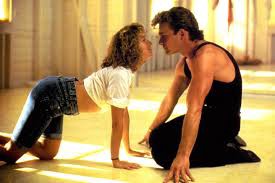Film anniversaries bring back memories, whether shared moments with friends, a first date, the beginning of fandom or for co-founder @Mark Pogachefsky, a project he worked on as a young publicist. In the case of Dirty Dancing, celebrating its 34th anniversary this year, it’s also an opportunity to reminisce about a beloved film and to reflect on how much has changed in film publicity over the years.
Dirty Dancing was not expected to be a hit. The abortion scene made it difficult to secure promotion partners and distributor Vestron was only planning a limited release to support home video sales. Patrick Swayze was only just on the rise, with Ghost and Point Break still in his future and Jennifer Gray was a relative newcomer. Director Emile Ardolino was best known for television dance series and documentaries, including the Academy Award-winning He Makes Me Feel Like Dancing. Choreographer Kenny Ortega, who went on to direct The Newsies, Hocus Pocus and Michael Jackson’s This is It and producer Linda Gottlieb, also came out of television. Writer Eleanor Bergstein probably had the most film credits having written It’s My Turn, which starred Michael Douglas and Jill Clayburgh. Ironically it was a dance scene cut out of that film that resulted in turning her personal Catskills experience into Dirty Dancing.
Hitting the cultural zeitgeist with its underlying themes of race, sexuality and class, Dirty Dancing made over $214 million worldwide at the box office and was the first film to sell over one million home video copies. The soundtrack generated two multi-platinum albums and multiple singles including (I’ve Had) The Time of My Life, which won both an Oscar and a Grammy. There was a prequel, a stage production and a television remake. The original regularly plays on television. I know because I watch it every time.
Mark’s strongest memories were helping to secure a New York Times Arts & Leisure front page feature and the review which described it as “a metaphor for America in the summer of 1963 — orderly, prosperous, bursting with good intentions, a sort of Yiddish-inflected Camelot,” as well as a raucous Los Angeles premiere. Turnout for the event exceeded seating capacity but when Cher turned up right after the film started with Rob Camilletti, two folding chairs were found so they could sit just behind the last row. The party that followed was at iconic 50s diner Ed Debevic’s.
While The New York Times remains important as a tastemaker, the campaign would be quite different today. With so many iconic images, including the famous lift scene, and lines like “No one puts Baby in a corner,” Dirty Dancing was made for social media. Exclusive clip placements, memes and gifs not to mention TikTok dance challenges would have been part of the campaign. Emphasis would be placed on having a female writer and producer and a diverse ensemble. There would be tie-ins with shows like Dancing With the Stars, which Gray went on to win years later. Reviews would still be important but so would online and broadcast interviews with the cast and production team and encouraging coverage of the issues addressed by the film.
We all may be able to find out exactly how different the campaign would be if the proposed sequel announced in 2020 with Jennifer Gray on board actually gets produced.
